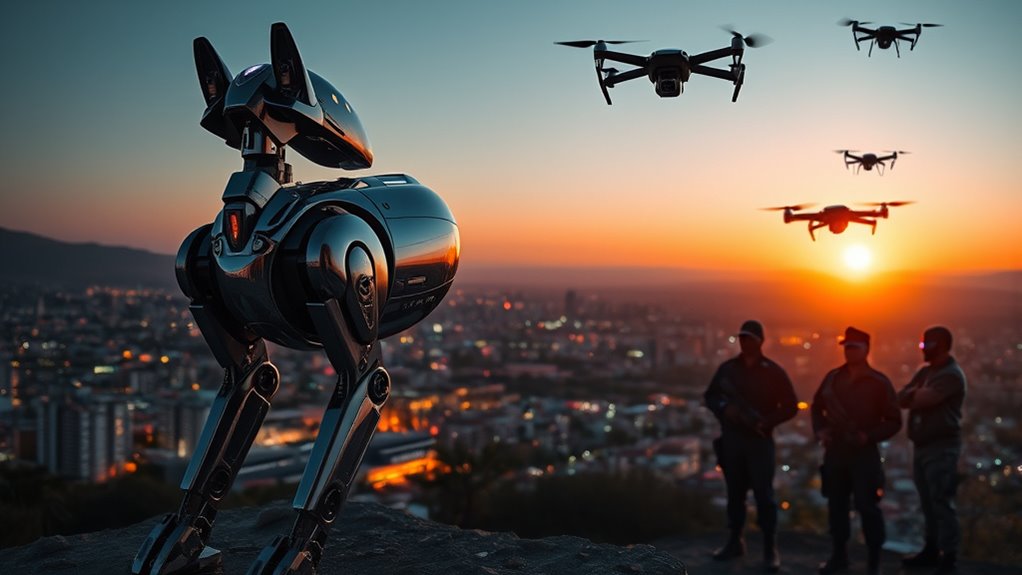Chinese robotic dogs are transforming military strategy and global tech dominance with their advanced AI and capabilities. These robotic systems enhance combat efficiency, gather intelligence autonomously, and adapt to diverse environments. Their stealth and modular design offer critical tactical advantages. Countries worldwide are responding by ramping up their robotic technologies and reassessing defense strategies. If you’re curious about the implications of this tech shift and what’s next, you’ll want to explore further.
Key Takeaways
- China’s advancements in AI-integrated robotic dogs position them as leaders in military tech, enhancing operational capabilities and strategies.
- These robotic dogs exhibit superior adaptability and autonomous decision-making, increasing efficiency in military and security applications.
- The modular design allows for rapid upgrades, making them suitable for diverse mission requirements and evolving threats.
- Global reactions include heightened military development in the US and Russia, aiming to counter China’s growing technological influence.
- Concerns over privacy and ethical implications arise as nations deploy robotic dogs for public security and surveillance.
The Rise of AI-Integrated Robotic Dogs
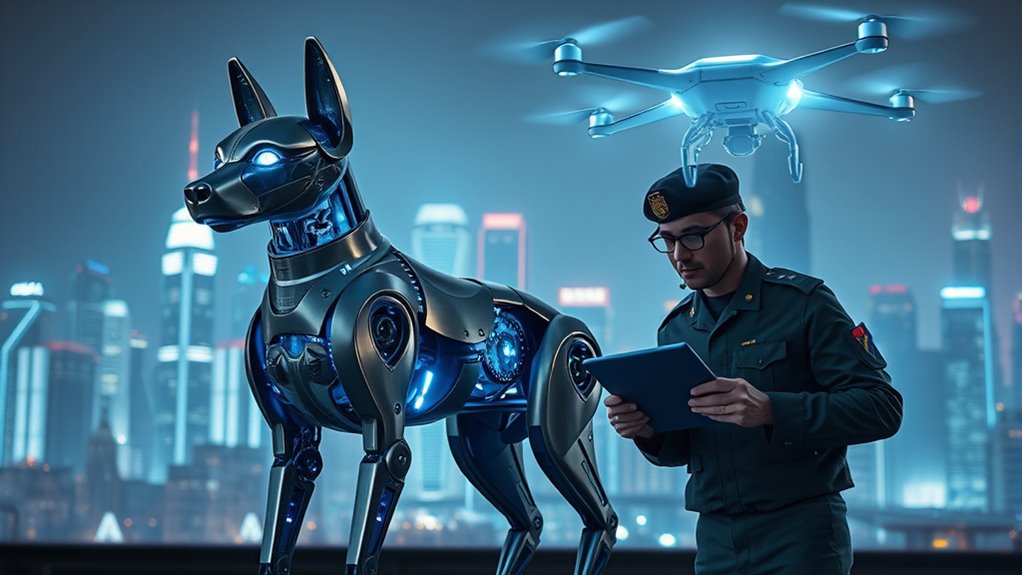
As advancements in artificial intelligence continue to evolve, AI-integrated robotic dogs are emerging as a groundbreaking innovation in robotics.
These robotic companions leverage AI-powered navigation, allowing them to independently traverse complex terrains. Thanks to large-scale AI simulation training, they continuously improve their advanced gaits and adaptability.
By integrating sensors like LiDAR, they achieve precise mapping and navigation, enhancing their performance even further. With robust machine learning models, these robotic dogs autonomously recognize patterns and make decisions on the go.
Integrating LiDAR sensors, these robotic dogs enhance navigation and decision-making through advanced machine learning capabilities.
Their bionic design, coupled with high-tech materials and advanced actuation systems, guarantees exceptional agility and durability.
As battery technology improves, you’ll witness these robotic dogs transforming industrial applications, from inspections to logistics, making them indispensable in various sectors.
Military Applications and Tactical Advantages
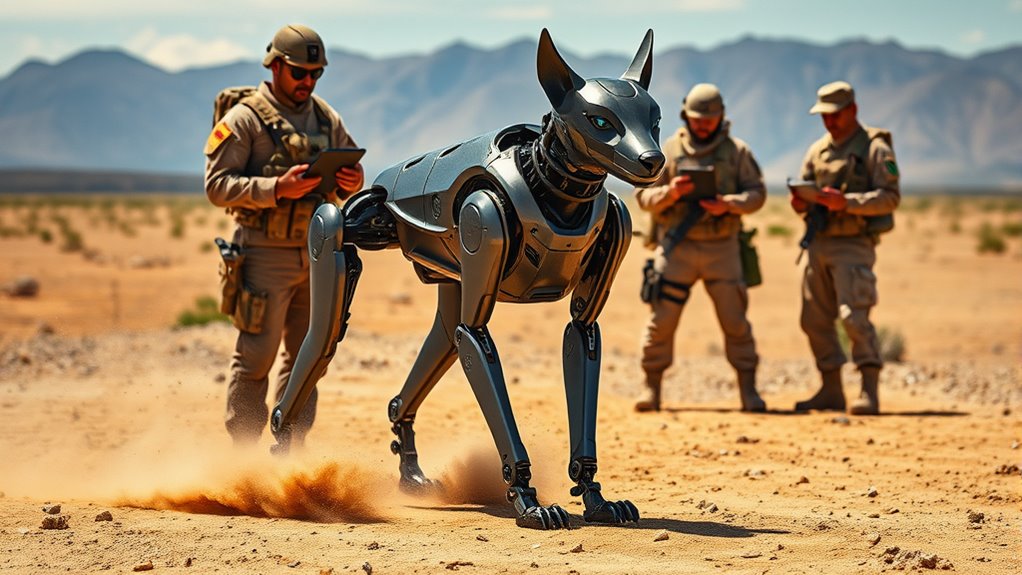
While traditional military operations rely heavily on human soldiers, robotic dogs are revolutionizing combat roles by taking on tasks that enhance efficiency and safety.
These advanced machines can engage enemies, gather intelligence, and navigate challenging terrains autonomously, reducing human risk. Equipped with weapons like rifles or grenade launchers, they provide a tactical edge in stealth operations, allowing for undetected deployments.
Their agility makes them perfect for urban warfare, where they can infiltrate areas inaccessible to troops. With real-time intelligence capabilities, they boost tactical decision-making and are cost-effective compared to manned units.
The modular design allows for quick upgrades, ensuring adaptability for various mission requirements, making robotic dogs an invaluable asset in modern military strategy.
Enhancing Public Security Through Technology

Through the integration of cutting-edge technology, cities are increasingly utilizing robotic dogs to enhance public security.
In areas like the Beijing Economic-Technological Development Area, robotic dogs work alongside autonomous vehicles and manned patrol cars, forming an intelligent patrol system. Labeled with “Patrol, Publicity, and Prevention,” these robotic canines engage the public while enforcing safety regulations, especially during health crises like COVID-19.
They monitor streets and indoor spaces, equipped with cameras and AI for effective surveillance. Public demonstrations in locations such as Boda Park have sparked interest, showcasing their dual role in safety and public interaction.
However, these advancements also raise concerns about privacy and data collection, highlighting the need for balance in security technology deployment.
Technological Innovations Driving Development
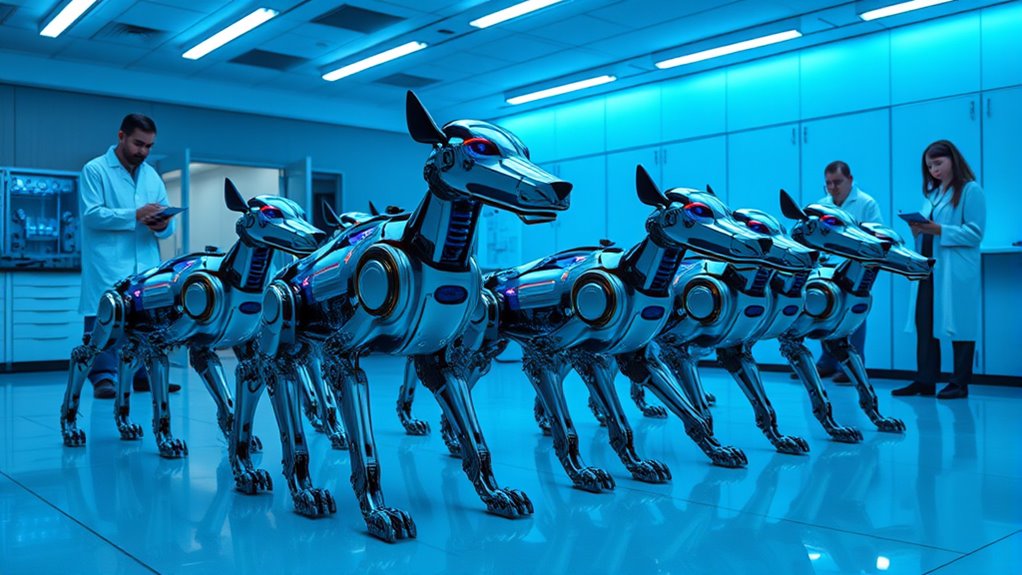
Robotic dogs are at the forefront of technological innovations that drive development in various sectors. With AI integration, these machines can navigate independently and collaborate effectively.
Reinforcement learning and advanced motion control algorithms give them lifelike agility and stability. Their quadrupedal designs enhance versatility, while some models even walk on two legs, opening new applications.
Equipped with advanced sensory systems, robotic dogs gather intelligence and adapt to their environments, functioning seamlessly in diverse conditions. Additionally, their payload capacity and terrain adaptability make them invaluable for industrial inspections and disaster response.
Economic Impact of Mass Production
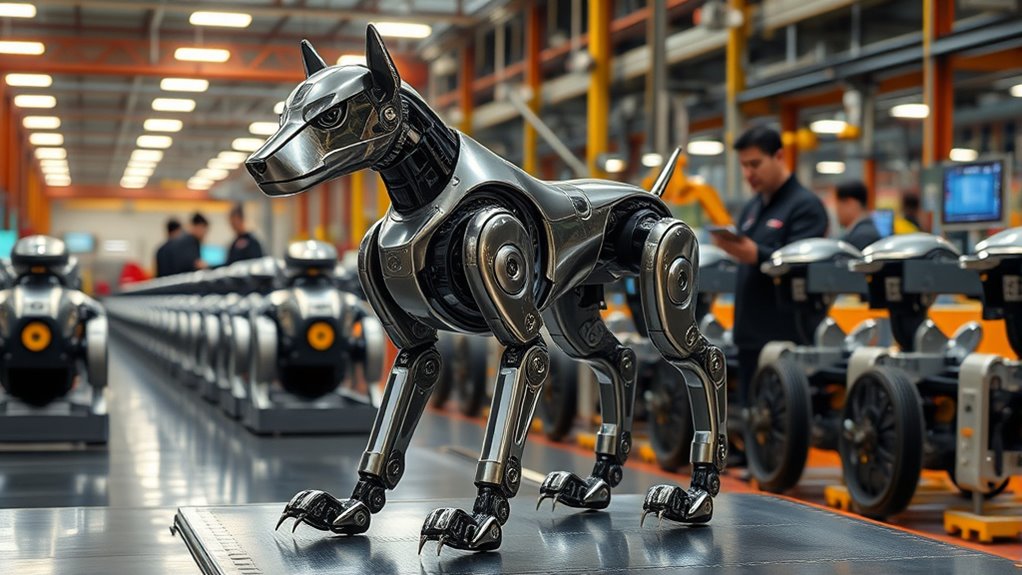
As mass production of robotic dogs accelerates, the economic landscape is shifting dramatically. You’ll notice the global humanoid robotics market projected to hit $7 trillion by 2050, with China capturing a significant share.
Domestic investment in the robotics sector is booming, bolstered by government support and subsidies that fuel manufacturing adoption. Lower labor costs in China enhance competitive production, while economies of scale drive down unit costs.
Although automation may displace some jobs, it creates new roles in maintenance and programming, requiring a skilled workforce. As Chinese robotics companies expand globally, they’re positioned to dominate the market, leading to increased foreign exchange earnings and a versatile economy that adapts to diverse sectors like military and public security.
Global Reactions and Concerns

While nations grapple with the rapid advancement of Chinese robotic dogs, concerns about military capabilities and strategic implications are mounting.
Countries like the US and Russia are racing to enhance their own robotic warfare technologies, fearing that China’s lead could shift the balance of power.
The US military’s interest in these robotic dogs highlights the potential for integration into training and operations, despite significant national security worries.
Lawmakers are particularly alarmed by the idea of these dogs armed with rifles, emphasizing the risks of autonomous operations and stealth capabilities.
As China diversifies its military strategies with these versatile robots, other nations are forced to reassess their defense plans to keep pace in this evolving landscape.
Ethical Implications and Future Warfare Challenges
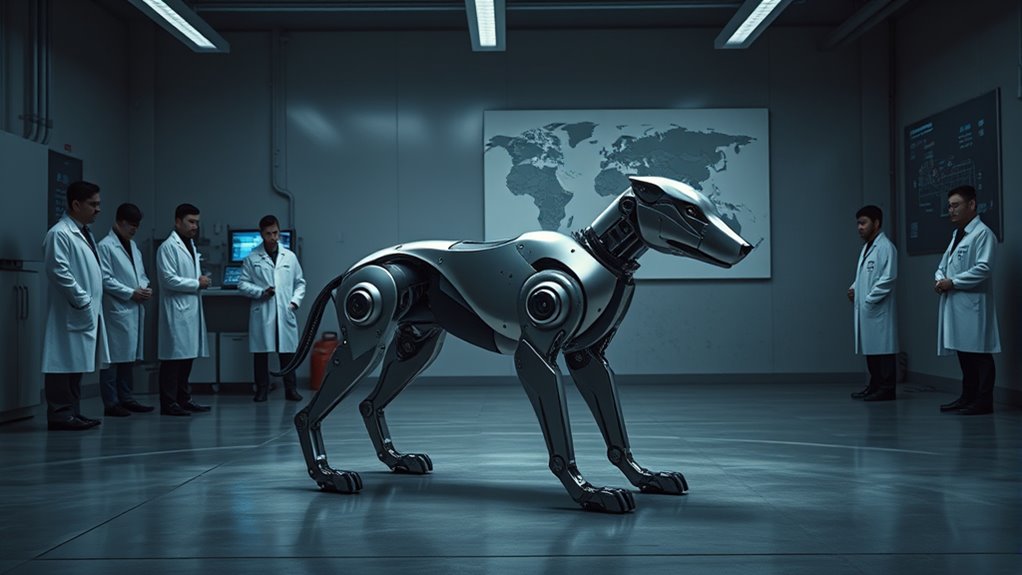
The rise of robotic dogs in military applications raises profound ethical implications that demand urgent attention. You might wonder about the replacement of real dogs to minimize their risk, yet this also raises questions about the autonomy of these machines.
Can we trust AI to make life-and-death decisions in conflict? As privacy concerns grow due to their surveillance capabilities, we must consider the accountability for civilian casualties caused by robotic actions.
Future warfare challenges include China’s technological superiority, which intensifies an arms race. The reliance on AI opens doors to cybersecurity risks and necessitates training for effective integration.
As you reflect on these issues, the need for established international norms becomes clear to guarantee ethical usage in warfare.
Frequently Asked Questions
How Do Robotic Dogs Communicate With Each Other in Swarms?
Robotic dogs communicate in swarms using wireless protocols like Wi-Fi and Bluetooth, allowing them to coordinate their actions seamlessly.
You’ll find they share sensor data to adapt their movements in real time, enhancing their collective behavior.
Each dog relies on decentralized control systems to make decisions based on local information.
This collaboration enables them to respond to threats and navigate diverse environments effectively, maintaining formation and executing coordinated maneuvers.
What Are the Limitations of Current Robotic Dog Technology?
Imagine your trusty old flip phone trying to compete with today’s smartphones. That’s how current robotic dog technology feels.
They struggle with structural integrity under firearm recoil, limited payload capacity, and energy efficiency, often running out of juice after just two hours.
Their speed and agility suffer on complex terrains, while full autonomy remains a dream.
Plus, integrating seamlessly with human teams and ensuring cybersecurity are ongoing challenges that need addressing for real-world effectiveness.
Can Robotic Dogs Be Hacked or Controlled Maliciously?
Yes, robotic dogs can be hacked or controlled maliciously.
If you use tools like Flipper Zero, you could exploit vulnerabilities in their systems. Many robotic dogs have undocumented backdoors or insecure communication protocols, making them susceptible to unauthorized access.
If you don’t change default credentials or regularly update the software, you risk exposing the device to hackers.
Awareness of these vulnerabilities is essential for ensuring the safety and integrity of robotic technologies.
What Specific AI Algorithms Do These Robots Use?
Isn’t it ironic that while you might think robotic dogs just fetch your slippers, they’re actually powered by cutting-edge AI algorithms?
These robots use reinforcement learning to adapt and learn from their surroundings. Generative pre-trained models help mimic natural movements, while hierarchical frameworks guarantee they can build on past knowledge.
Autonomous decision-making allows them to act independently, making them not just loyal companions but also efficient, intelligent machines ready for various tasks.
Are There Any Civilian Uses for Armed Robotic Dogs?
Yes, there are several civilian uses for armed robotic dogs. You can utilize them in search and rescue operations, as they navigate hazardous environments effectively.
Their agility makes them ideal for urban security patrols, while they can monitor environmental conditions in difficult areas.
Additionally, these robots can assist in public safety, crowd control, and even serve as companions for individuals with disabilities, enhancing their quality of life.
Conclusion
As you witness the rise of Chinese robotic dogs, you see a transformation in military strategy, a shift in public security, and a challenge to global tech dominance. These advancements enhance capabilities, reshape economies, and spark ethical debates. While you embrace the innovative spirit driving this technology, you must also grapple with the implications for future warfare. Ultimately, as robotic dogs patrol our streets and battlefields, you’re left to contemplate the balance between progress and responsibility.
